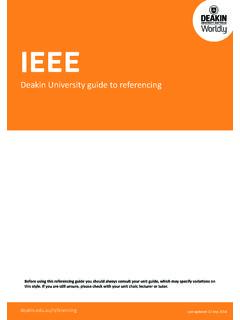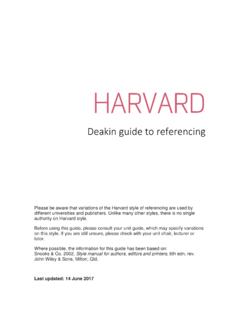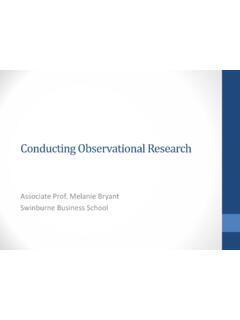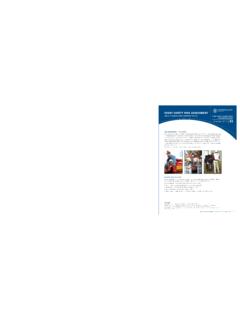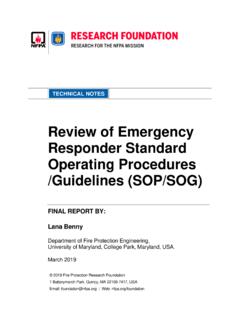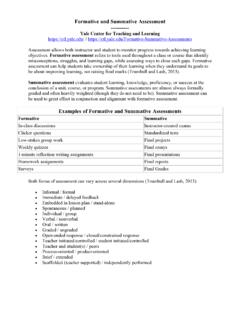Transcription of Peer and Self assessment - Deakin University
1 peer and self assessmentDeveloped by Deakin Learning Futures, Deakin AND self assessment TABLE OF CONTENTSWHAT ARE peer AND self assessment ? 3 WHY ARE peer AND self assessment IMPORTANT? 3 TEACHING peer assessment 4 GENERAL POINTS FOR peer assessment 4 HOW TO IMPLEMENT peer assessment EFFECTIVELY 4 EXAMPLES OF peer assessment ACTIVITIES (FORMATIVE AND SUMMATIVE) 5 TEACHING self assessment 6 GENERAL POINTS FOR self assessment 6 HOW TO IMPLEMENT self assessment EFFECTIVELY 6 EXAMPLES OF self assessment ACTIVITIES (FORMATIVE AND SUMMATIVE assessment ) 7 TEACHING peer AND self assessment ACROSS A course 8 ASSESSING peer AND self assessment 9 GENERAL POINTS 9 HOW TO ASSESS peer assessment 9 peer assessment COLLABORATION rubric 9 SOME TIPS FOR peer assessment 11 HOW TO ASSESS self assessment 12 EXAMPLES OF peer AND self assessment RUBRICS 13 DIVERSITY AND EQUITY 14 HOW TO GUIDE STUDENTS TO CAPITALISE ON DIVERSE BACKGROUNDS 14 HOW TO ENSURE ALL STUDENTS, ARE SUPPORTED AND INCLUDED 14 FURTHER READINGS & OTHER RESOURCES 16 ARTICLES 16 VIDEOS 16 REFERENCES 17 DEVELOPMENT OF THE peer AND self assessment TEACHING RESOURCE 18 peer and self assessment 3 WHAT ARE peer AND self assessment ?
2 peer assessment is an arrangement when students make assessment decisions on other students work self assessment occurs when a student assesses and makes judgements about his/her own work. peer and self assessment are linked to reflective practice as it involves self development and as such, is an important skill for career development and can make peer and self assessment decisions on various assessment forms including essays, reports, presentations, performances, projects, dissertations and exams. peer and self assessment can play a vital role in formative assessment and can also be used as a component for summative assessment , helping to provide the following outcomes: a desire to want to learn (intrinsic motivation) a need to learn (extrinsic motivation) learning by doing (practice, trial and error) learning through feedback (praise, constructive criticism) making sense or digesting what has been ARE peer AND self assessment IMPORTANT?
3 Some key points about peer and self assessment are1 they are valuable when the evidence to be assessed is intrinsically personal in nature sometimes students themselves know how well the evidence meets the purposes or criteria designed to specify it the feedback/ assessment can be anonymous, allowing students a comfortable space to give constructive feedback and receive feedback consistency in understanding key concepts can be demonstrated (or lack of consistency can alert tutors to problems) each can be adopted to provide formative ( , assessment for learning) and/or summative ( , assessment of learning) assessment peer and self assessment can potentially save time and classroom work, because a teacher can receive a clearer or indepth perspective on the strengths and weaknesses of a student s learning experience and can then hone in on the problem areas peer and self assessment can assist in deepening the student s own perception of their learning style and experience, facilitating ammelioration peer assessment can help steer students towards understanding the assessment process, helping students take control of their own learning and assessment and become more independent learners peer assessment can help students acquire a range of transferable key skills such as self -reflection, time management.
4 Organisational and team skills which are highly valued in the workplace and underpin career progression. 1 UNSW Australia, retrieved 28 May 2013, < >. peer and self assessment 4 TEACHING peer ASSESSMENTG eneral points for peer assessment academics should explicitly discuss with, and inform, students about peer assessment expectations and objectives academics should explicitly encourage students, and provide them with the tools to give their peers positive and constructive feedback that is productive and professional academics should stress to students to be sensitive when giving feedback to their peers- illustrating good practice examples of what constitutes a negative peer assessment and a positive one peer assessment can facilitate student s personal coping skills and strategies for self regulating learning.
5 Providing motivation and recognising progress academics should be aware that giving students too little responsibility may mean that students may feel lost and unclear about what to do. How to implement peer assessment effectivelyWhen developing a peer assessment task: construct a clear and accurate rubric to establish proper criteria and standards for the assessment piece engage the students in practice opportunities (formative assessment ) before employing peer assessment as a assessment where peer assessment is used to give feedback on a fellow student s contribution to the team, explain to students that contribution to teamwork can occur in either premium located situations or in CloudDeakin contexts. Therefore, it should be the content and extent of a student s contribution, not just the number of meetings that they attend that is and self assessment 5 Examples of peer assessment activities (formative and summative)Table 1.
6 Tools and resources for peer assessmentName of resourceWhat it is used forWhere to find itDevelopment of a peer assessment tool for engineering studentsProblem based Capital Language Resource Centre (NCLRC) Assessing LearningThe use of peer assessment in language and Teaching Support NetworkAn overall explanation and discussion regarding peer is an open source online peer assessment tool being used extensively in the UK and at University of Queensland and University of New South Wales in is a web-based self and peer assessment kit provided by the University of Technology, PeerMark is a peer assessment tool available as part of the Turnitin within Cloud DeakinePortfolio within CloudDeakin has the ability to allow students to share and comment on each other s life practiceStudents could be asked to peer review (as well as self -assess)
7 Resumes and performance at mock interviews/interview simulationsLed by academicPeer and self assessment 6 TEACHING self ASSESSMENTG eneral points for self assessment explaining the rules and process of the self assessment activity and why it is important to both learning and real world environments, as well as, important for establishing realistic expectations providing a rubric or outline for the students to follow in order to authentically self assess their work is crucial in providing students with motivation to complete the task allowing for prior formative self assessment activities to help scaffold the self assessment activity is important for establishing self -directed to implement self assessment effectivelyAcademics should consider the following.
8 Provide students with thorough and accurate self - assessment processes provide and explain self assessment activities that are self -critical and realistic and include effective monitoring and improvement of performance through on-going self assessment avoid insufficient teacher-involvement in self - assessment processes avoid inadequate use of self - assessment feedback to support improvement in student and self assessment 7 Examples of self assessment activities (formative and summative assessment )Table 2. Tools for self assessmentName of resourceWhat it is used forWhere to find itMediawikiA web-based learning tool for group activity (or individuals) that allows users to upload artefacts on set topics and projects.
9 The process and product can then undergo self and/or peer assessment . there is a link to wikis on CloudDeakin: a conference presentation on wikis: :30005482 how to implement and use mediawikis: web-based form that teachers can create in CloudDeakin that allows teachers and students to peer and self assess. Once students have filled in the form they can submit the assessment via CloudDeakin s Dropbox. CloudDeakin: is a web-based self and peer assessment kit provided by the University of Technology, PeerMark is a peer assessment tool available as part of the Turnitin s self Directed SearchPersonality typing and assessment instrument. Deakin Careers Consultants can administer. See also some free online versions Instrument to measure and articulate interests (available from Jobshop staff and website) audit and Career Action PlanTo set goals, identify skills and deficits and plan actions to address #job-search_action_plan__89_4 peer and self assessment 8 TEACHING peer AND self assessment ACROSS A COURSED evelopment of self and peer assessment skills should be scaffolded across a course , beginning in the first year of a course where foundation level skills are developed.
10 Successive years should build on the foundation skills developed, progressively challenging the student. Table 3 sets out some examples of self and peer assessment activities for novice ( , Year 1 students) and more experienced 3. An example of peer and self assessment for novice and experienced studentsLevelPeerSelfNoviceStudents assess other s assignments using a teacher designed rubric student writes identify three aspects that were completed well students provides feedback on three aspects where the peer needs to improve academic provides formative feedback, picking up on the themes in the Academic provides examples of reflective practice and details a framework of how to undertake reflection (examples from previous student cohorts may be useful).
